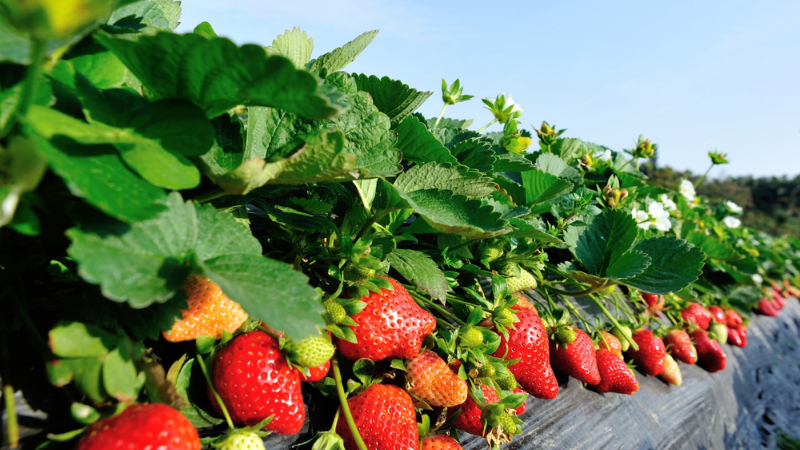Drought May Cause Pest Migration To California Cucurbit Crops
The drought may stop the spread of some plant diseases in California this year, but what some growers and researchers are finding is the insects that typically feed in weedy areas and pastures moved to cropping areas earlier in the season as the weedy areas have dried up.
Looking for new places to feed, these insects migrate from the non-crop areas to crops, transmitting viruses and disease along the way.

To mitigate losses, as shown here and above with the deformed squash and yellowed leaves, scout your fields so you can take action to reduce pest populations.
Photo courtesy of Steve Koike
Viruses Of Cucurbits
Viruses that typically impact cucurbit crops such as watermelon, squash, pumpkin, and cucumbers include cucumber mosaic virus, papaya ringspot virus, watermelon mosaic virus, and zucchini yellow mosaic virus. All of these are aphid vectored viruses. California also gets some squash mosaic virus which is spread by the spotted cucumber beetle, Koike adds.
The final malady seen periodically out West is the curly top virus, which is vectored by leafhoppers. This disease impacts cucurbits and a host of other crops.
Koike points out that it is very difficult to distinguish the symptoms of the different viruses. He adds, however, that in most cases, growers know that on all cucurbits, these viruses cause leaf deformities and discoloring of the foliage. Plus the fruit, although edible, is completely unmarketable.
“The fruit have bumps and are misshapen,” he says. “They are very much edible but not marketable because of how they look. Unfortunately, once the plant is infected, the grower can’t do anything to correct the problem.”
Infected But Productive
All is not lost, though. In some cases, the plant can be productive, and the fruit can be marketable, depending on when the insects fed on the plant.
“You may have a virus that causes the leaves to become yellow and deformed but you still get zucchini fruit, for example, that look pretty normal,” Koike says. “You have to observe what is happening with the crop because you may be able to still get fruit off the plants.”
It is a timing issue, he says, as growers can continue to harvest until they see that the fruit are no longer usable.
“These viruses are all systemic so they eventually move to all parts of the plants,” Koike explains. “Once that happens, and if it is a fruit deformity type virus, all the fruit will start showing deformities.”
Employ IPM Tactics
Koike advises growers to keep up with a sound IPM spray program keeping the viruses in mind, but warns that even though you have sprayed for the insect, whether it is aphid, beetle, or thrips, it doesn’t mean your plants are completely protected from the virus.
“It takes the insect anywhere from 30 seconds to 5 minutes to inject the virus,” he explains. “So the insect pest can feed for a brief amount of time, inject the virus, infecting the plant, but the insect then dies because you sprayed it. We know from research that vector control does not prevent diseases. However, the grower should still manage the vector.”
To further reduce the incidence of disease and virus pressure, Koike encourages growers to manage weeds and vegetation around cucurbit fields. He also says for growers who have the luxury of site selection, and are in an area that is at high-risk for viruses, to consider moving the cucurbits to another field. “Put your radishes in that field and put your squash someplace else where it is less of a risk,” he adds.
In the end, however, by paying close attention to what is occurring in your fields, you will be able to mitigate losses by keeping up with an IPM program and correctly identifying the insects and symptoms of viruses.
Two Water Conserving Tactics
The effects of the current drought — one of California’s most severe on record — have been far reaching. However, for one cucurbit crop — pickling cucumbers — the numbers have been relatively stable over the last several years due to better management practices by growers, including drip irrigation and reduced tillage.
The majority of pickle production in California is concentrated in the northern San Joaquin Valley and Delta area, according to Brenna Aegerter, farm advisor at the University of California Cooperative Extension. However, production does extend further south into Fresno County, which has been seriously impacted by the drought, posing a unique set of challenges for growers in the region.
One of the benefits of pickle production in the San Joaquin Valley is that the period from planting to harvest is a relatively short two months, meaning less water needs to be applied to the crop compared to longer-season crops such as tomatoes, Aegerter explains.
Like others in California and elsewhere, to manage the effects of the dry weather, she says some pickle growers have made the switch to drip irrigation. Aegerter advises to check to see if there are any leaks or clogged emitters in your drip system so water can be applied uniformly.
“If some of the emitters are plugged, then you’re getting less uniform application, and
you have to apply water for those emitters that are putting out the least amount of water,” she says.
Coupled with the use of drip irrigation, reduced tillage also provides moisture conservation advantages.
“Using only shallow tillage, as is often practiced in conjunction with buried drip tape — but could also be done with conventional furrow irrigation — reduces evaporation of any soil moisture you were able to accumulate over the winter,” she explains.









